Hoffman D.M., Singh B., Thomas J.H. (Eds). Handbook of Vacuum Science and Technology
Подождите немного. Документ загружается.

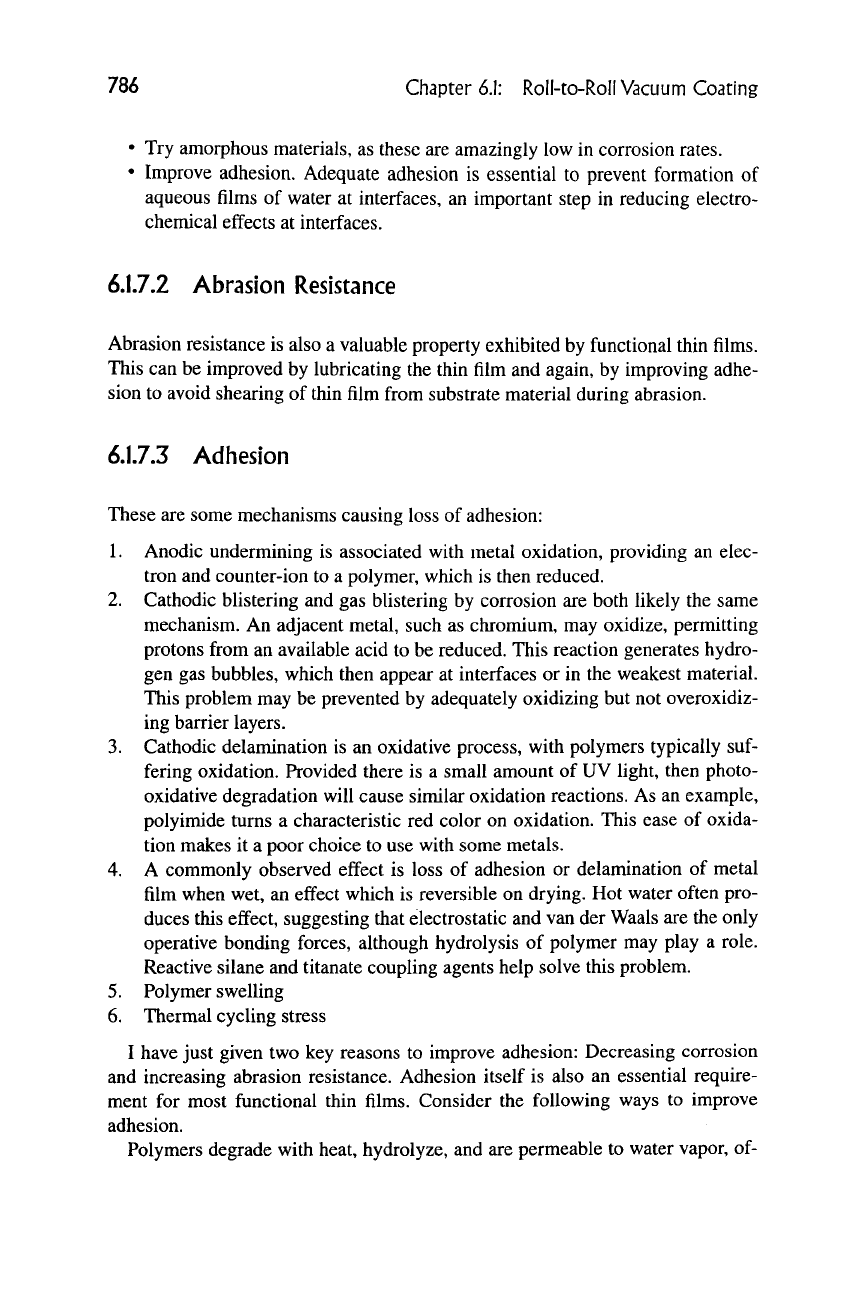
786 Chapter
6.1:
RolI-to-RoIl Vacuum Coating
• Try amorphous materials, as these are amazingly low in corrosion rates.
• Improve adhesion. Adequate adhesion is essential to prevent formation of
aqueous films of water at interfaces, an important step in reducing electro-
chemical effects at interfaces.
6.1.7.2 Abrasion Resistance
Abrasion resistance is also a valuable property exhibited by functional thin films.
This can be improved by lubricating the thin film and again, by improving adhe-
sion to avoid shearing of thin film from substrate material during abrasion.
6.1.7.3 Adhesion
These are some mechanisms causing loss of adhesion:
1.
Anodic undermining is associated with metal oxidation, providing an elec-
tron and counter-ion to a polymer, which is then reduced.
2.
Cathodic blistering and gas blistering by corrosion are both likely the same
mechanism. An adjacent metal, such as chromium, may oxidize, permitting
protons from an available acid to be reduced. This reaction generates hydro-
gen gas bubbles, which then appear at interfaces or in the weakest material.
This problem may be prevented by adequately oxidizing but not overoxidiz-
ing barrier layers.
3.
Cathodic delamination is an oxidative process, with polymers typically
suf-
fering oxidation. Provided there is a small amount of UV light, then photo-
oxidative degradation will cause similar oxidation reactions. As an example,
polyimide turns a characteristic red color on oxidation. This ease of oxida-
tion makes it a poor choice to use with some metals.
4.
A commonly observed effect is loss of adhesion or delamination of metal
film when wet, an effect which is reversible on drying. Hot water often pro-
duces this effect, suggesting that electrostatic and van der Waals are the only
operative bonding forces, although hydrolysis of polymer may play a role.
Reactive silane and titanate coupling agents help solve this problem.
5.
Polymer swelling
6. Thermal cycling stress
I have just given two key reasons to improve adhesion: Decreasing corrosion
and increasing abrasion resistance. Adhesion itself is also an essential require-
ment for most functional thin films. Consider the following ways to improve
adhesion.
Polymers degrade with heat, hydrolyze, and are permeable to water vapor, of-

References 787
ten supplying acids or bases to interfaces between polymers and thin films. These
limitations of polymers tend to speed corrosion and decrease adhesion, resulting
in possible product failure.
An amorphous layer generated by exposure of some polymers to flashlamps
may be used to toughen the polymer surface. On deposition of a thin film, the
amorphous layer improves cohesive strength in the polymer near the interface.
Plasma priming at low pressure can improve adhesion and reduce corrosion
rates of metal films deposited on polymer substrates. Prior to thin-film deposition,
a plasma of an appropriate gas may be generated adjacent to a polymer surface.
This process may create coordination or covalent bonds between polymer sub-
strate and vacuum-deposited thin films. Oxidizing plasmas also remove surface
layers and weakly bound contaminants, typically a thickness of 10 to 20 nm; plas-
mas often smooth polymer surfaces. The effects of plasma treatment are very
stable, because plasma exposure produces a significant chemical change at the
surface. Surface modification and adhesion enhancement by plasma chemistry is
a process confined to surface layers. Vacuum ultraviolet light generated by such
plasma affects deeper layers of polymers.
Reduced oxidation and improved stability may be achieved at interfaces be-
tween polymer surfaces and metal films by forming an appropriate barrier film
at such interfaces. The barrier should coordinate well with the plasma-treated
substrate. Barrier films should be thin, insoluble, and not electrically conducting;
the last item helps decrease electrochemical interactions. Once the substrate is
in vacuum, one wants to provide as many coatings as possible in one pass, such
as plasma priming, barrier and nucleation films, functional films, overcoats, and
lubricants.
REFERENCES
1.
L. I. Maissel and R. Glang, Handbook of
Thin
Film Technology (McGraw-Hill, New York, 1983)
originally published 1970.
2.
J. L. Vossen and W. Kern, Thin Film Technology (Academic Press, New York, 1978).
3.
Don Griffin, "The new
C-MAGT"^*
dual rotatable sputtering cathode," Proc. Third Int.
Conf.
on
Vacuum Web Coating, San Antonio, Texas (1989), pp. 62-74.
4.
R. F. Bunshah, Deposition
Technologies
for Films and Coatings —Developments and Applica-
tions (Noyes Publications, Westwood, NJ, 1982), pp. 231-235.
5.
R. M. Bozorth, Ferromagnetism (Van Nostrand, New York, 1951).
6. J. Kieser, W. Schwarz, and W. Wagner, "On the Design of Vacuum Web Coaters," Thin Solid
Films, 119 (1984) pp. 217-222.
7.
W. M. Rohsenow and J. R Hartnett, eds.. Handbook of Heat Transfer (McGraw-Hill, New York,
1973),
pp. 3-14 to 3-18.
8. H. Fenech and W. M. Rohsenow, "Prediction of thermal conductance of metallic surfaces in
contact," J. Heat
Transfer,
Trans. The American Society of
Mechanical
Engineers, 85 (1963)
pp.
15-24.
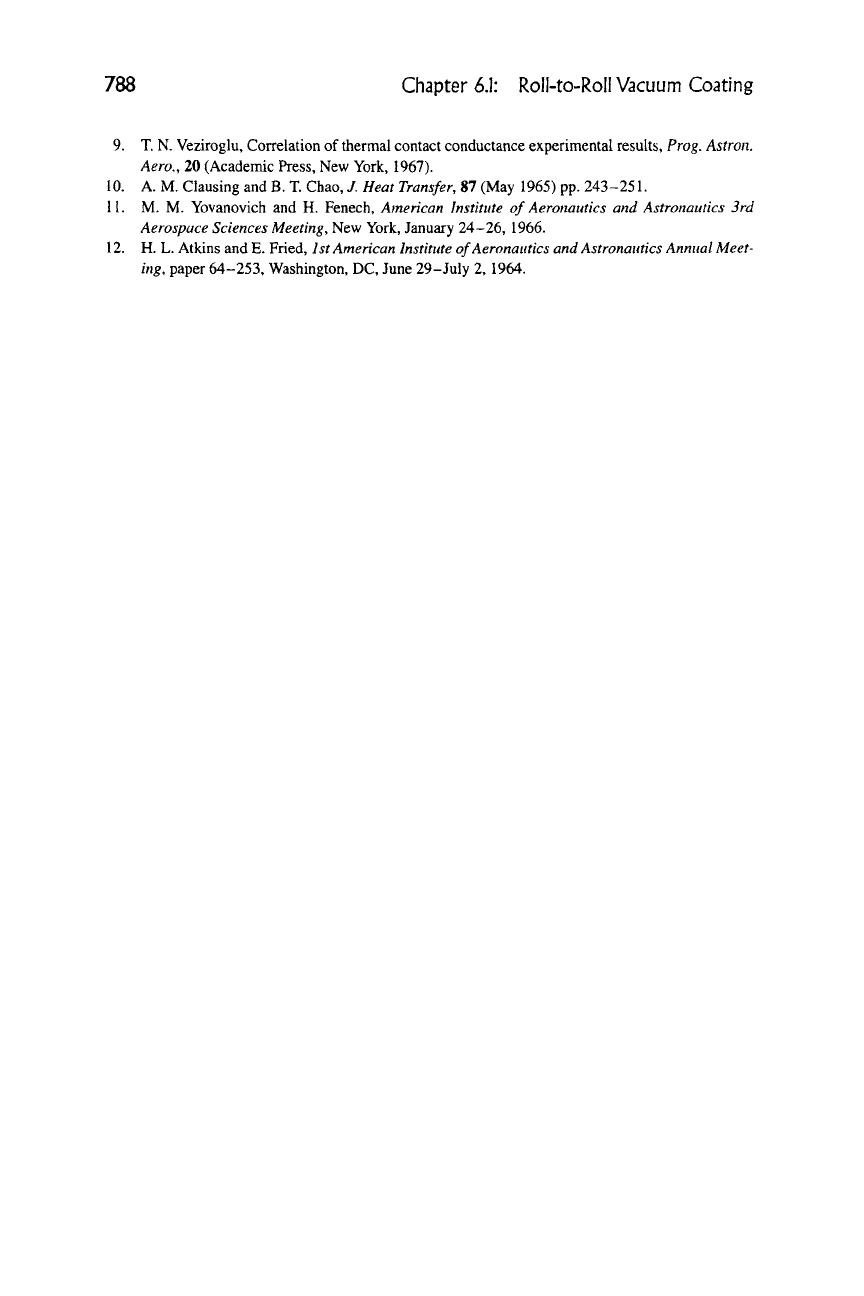
788 Chapter
6.1:
RoII-to-RoII Vacuum Coating
9. T. N. Veziroglu, Correlation of thermal contact conductance experimental results, Prog. Astron.
Aero.,
20 (Academic Press, New York, 1967).
10.
A. M. Clausing and B. T. Chao, / Heat Transfer, 87 (May 1965) pp.
243-251.
11.
M. M. Yovanovich and H. Fenech, American Institute of
Aeronautics
and Astronautics 3rd
Aerospace Sciences Meeting, New York, January 24-26, 1966.
12.
H. L. Atkins and E. Fried,
1st American Institute
of Aeronautics and
Astronautics Annual
Meet-
ing, paper 64-253, Washington, DC, June 29-July 2, 1964.
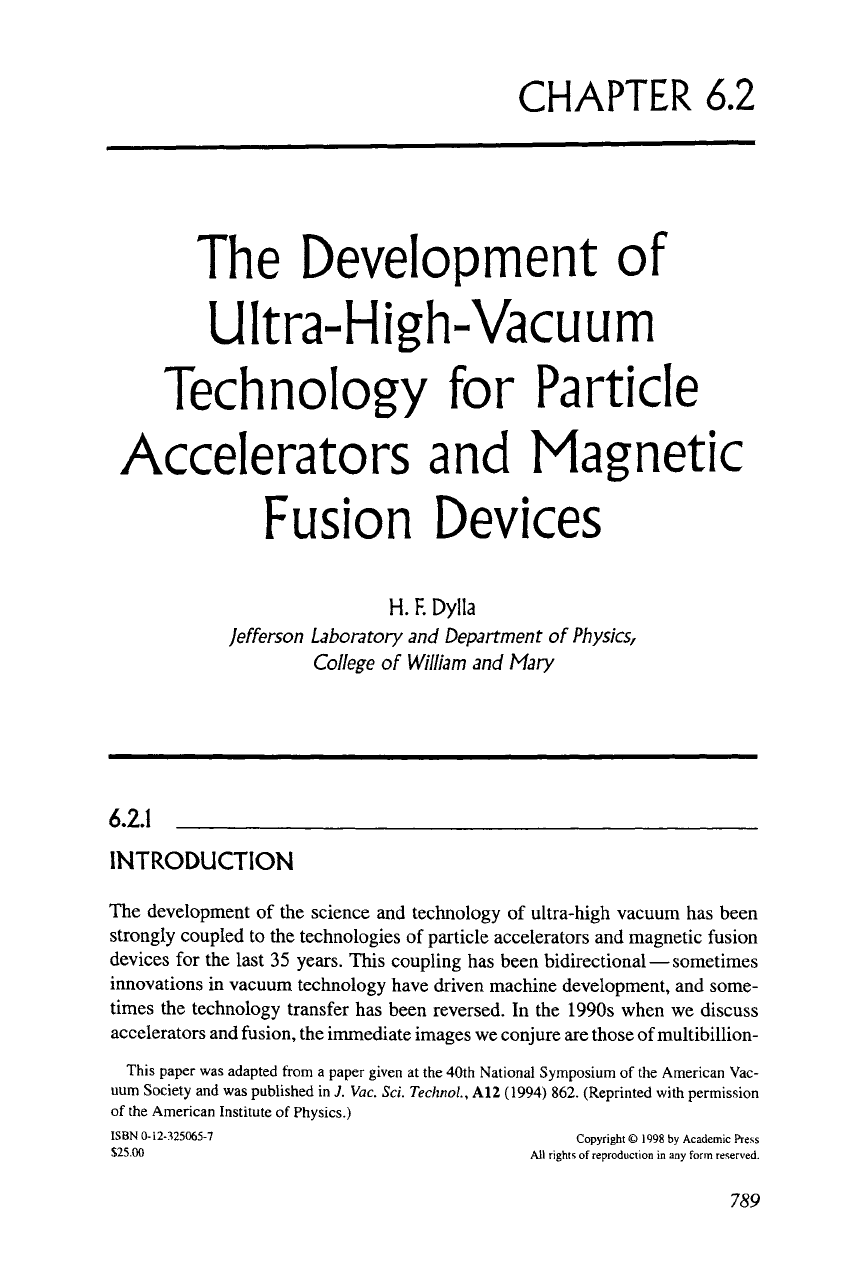
CHAPTER
6.2
The Development of
Ultra-High-Vacuum
Technology for Particle
Accelerators and Magnetic
Fusion Devices
H.
F.
Dylla
Jefferson Laboratory and Department
of
Physics,
College of
William
and Mary
6.2.1
INTRODUCTION
The development of the science and technology of ultra-high vacuum has been
strongly coupled to the technologies of particle accelerators and magnetic fusion
devices for the last 35 years. This coupling has been bidirectional—sometimes
innovations in vacuum technology have driven machine development, and some-
times the technology transfer has been reversed. In the 1990s when we discuss
accelerators and fusion, the inmiediate images
we
conjure are those of multibillion-
This paper was adapted from a paper given at the 40th National Symposium of the American Vac-
uum Society and was published in J.
Vac.
Sci. Technol, A12 (1994) 862. (Reprinted with permission
of the American Institute of Physics.)
ISBN 0-12-325065-7 Copyright © 1998 by Academic Press
$25.00 All rights of reproduction in any form reserved.
789
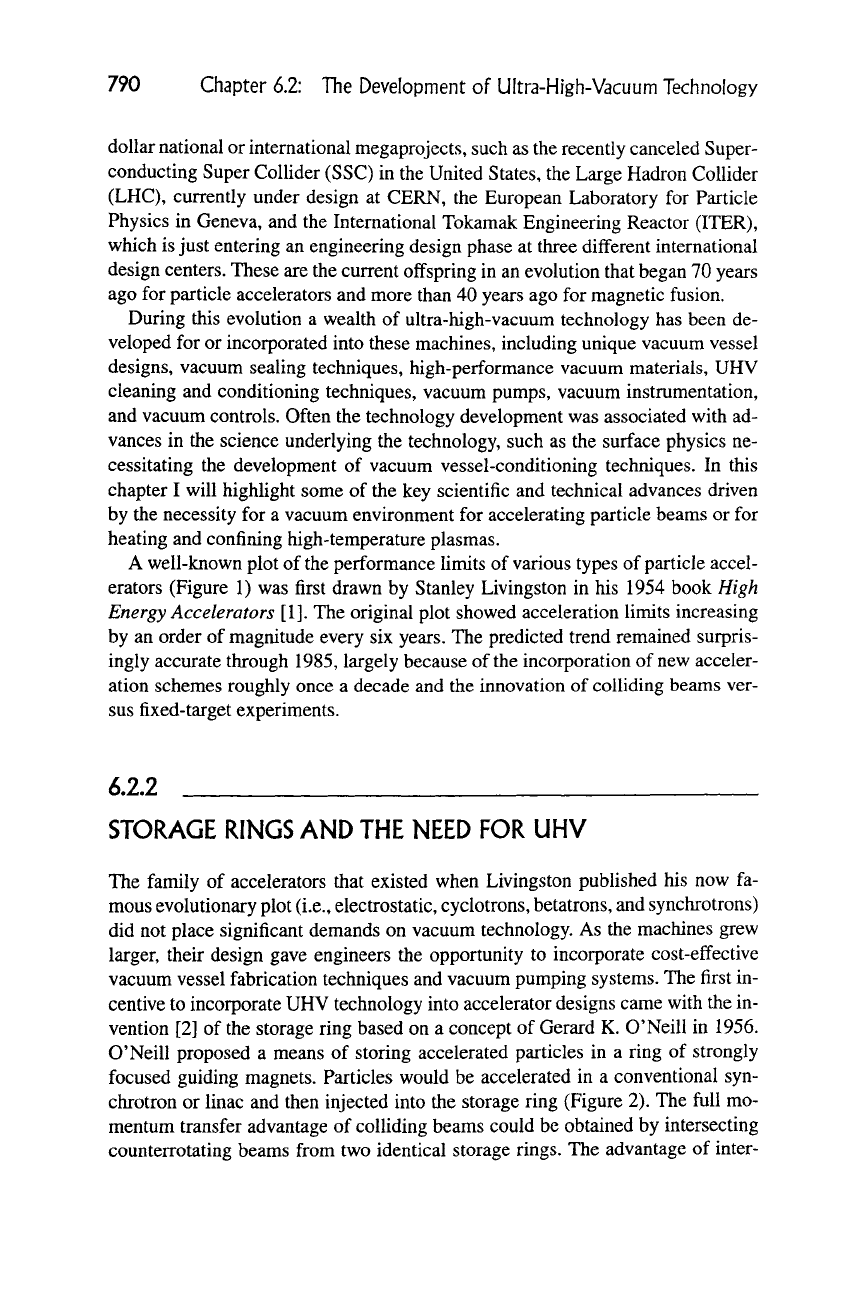
790 Chapter 6.2: The Development of Ultra-High-Vacuum Technology
dollar national or international megaprojects, such as the recently canceled Super-
conducting Super Collider (SSC) in the United States, the Large Hadron Collider
(LHC),
currently under design at CERN, the European Laboratory for Particle
Physics in Geneva, and the International Tokamak Engineering Reactor (ITER),
which is just entering an engineering design phase at three different international
design centers. These are the current offspring in an evolution that began 70 years
ago for particle accelerators and more than 40 years ago for magnetic fusion.
During this evolution a wealth of ultra-high-vacuum technology has been de-
veloped for or incorporated into these machines, including unique vacuum vessel
designs, vacuum sealing techniques, high-performance vacuum materials, UHV
cleaning and conditioning techniques, vacuum pumps, vacuum instrumentation,
and vacuum controls. Often the technology development was associated with ad-
vances in the science underlying the technology, such as the surface physics ne-
cessitating the development of vacuum vessel-conditioning techniques. In this
chapter I will highlight some of the key scientific and technical advances driven
by the necessity for a vacuum environment for accelerating particle beams or for
heating and confining high-temperature plasmas.
A well-known plot of the performance limits of various types of particle accel-
erators (Figure 1) was first drawn by Stanley Livingston in his 1954 book High
Energy Accelerators [1]. The original plot showed acceleration limits increasing
by an order of magnitude every six years. The predicted trend remained surpris-
ingly accurate through 1985, largely because of the incorporation of new acceler-
ation schemes roughly once a decade and the innovation of colliding beams ver-
sus fixed-target experiments.
6.2.2
STORAGE RINGS AND THE NEED FOR UHV
The family of accelerators that existed when Livingston published his now fa-
mous evolutionary plot
(i.e.,
electrostatic, cyclotrons, betatrons, and synchrotrons)
did not place significant demands on vacuum technology. As the machines grew
larger, their design gave engineers the opportunity to incorporate cost-effective
vacuum vessel fabrication techniques and vacuum pumping systems. The first in-
centive to incorporate UHV technology into accelerator designs came with the in-
vention [2] of the storage ring based on a concept of Gerard K. O'Neill in 1956.
O'Neill proposed a means of storing accelerated particles in a ring of strongly
focused guiding magnets. Particles would be accelerated in a conventional syn-
chrotron or linac and then injected into the storage ring (Figure 2). The full mo-
mentum transfer advantage of colliding beams could be obtained by intersecting
counterrotating beams from two identical storage rings. The advantage of inter-
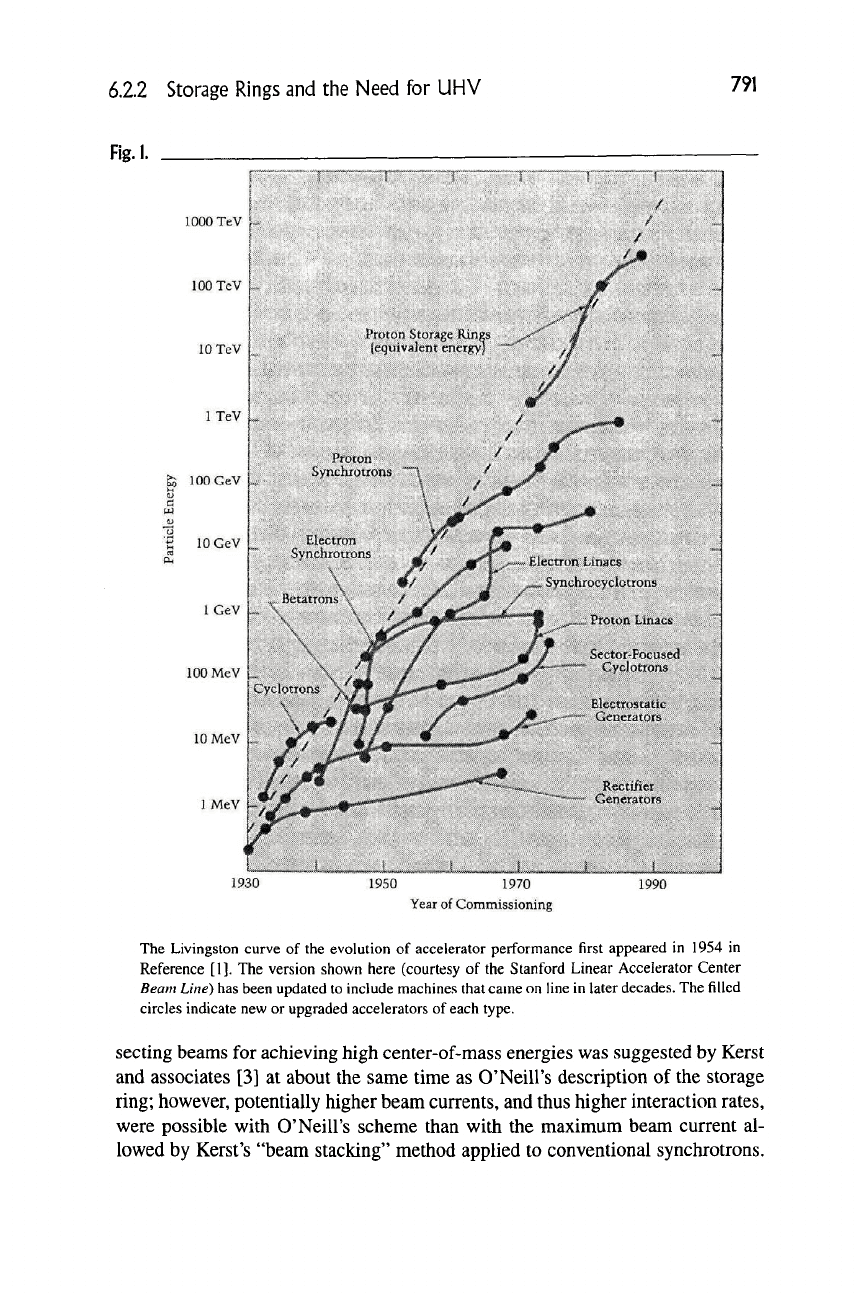
6.2.2 Storage Rings and the Need for UHV
791
Fig.l.
100 MeV
10 MeV
L
1
MeV K
1930
1950 1970
Year
of Commissioning
1990
The Livingston curve of the evolution of accelerator performance first appeared in 1954 in
Reference [1]. The version shown here (courtesy of the Stanford Linear Accelerator Center
Beam Line)
has been updated to include machines that came on fine in later decades. The filled
circles indicate new or upgraded accelerators of each type.
secting beams for achieving high center-of-mass energies was suggested by Kerst
and associates [3] at about the same time as O'NeiU's description of the storage
ring; however, potentially higher beam currents, and thus higher interaction rates,
were possible with O'Neill's scheme than with the maximum beam current al-
lowed by Kerst's "beam stacking" method applied to conventional synchrotrons.
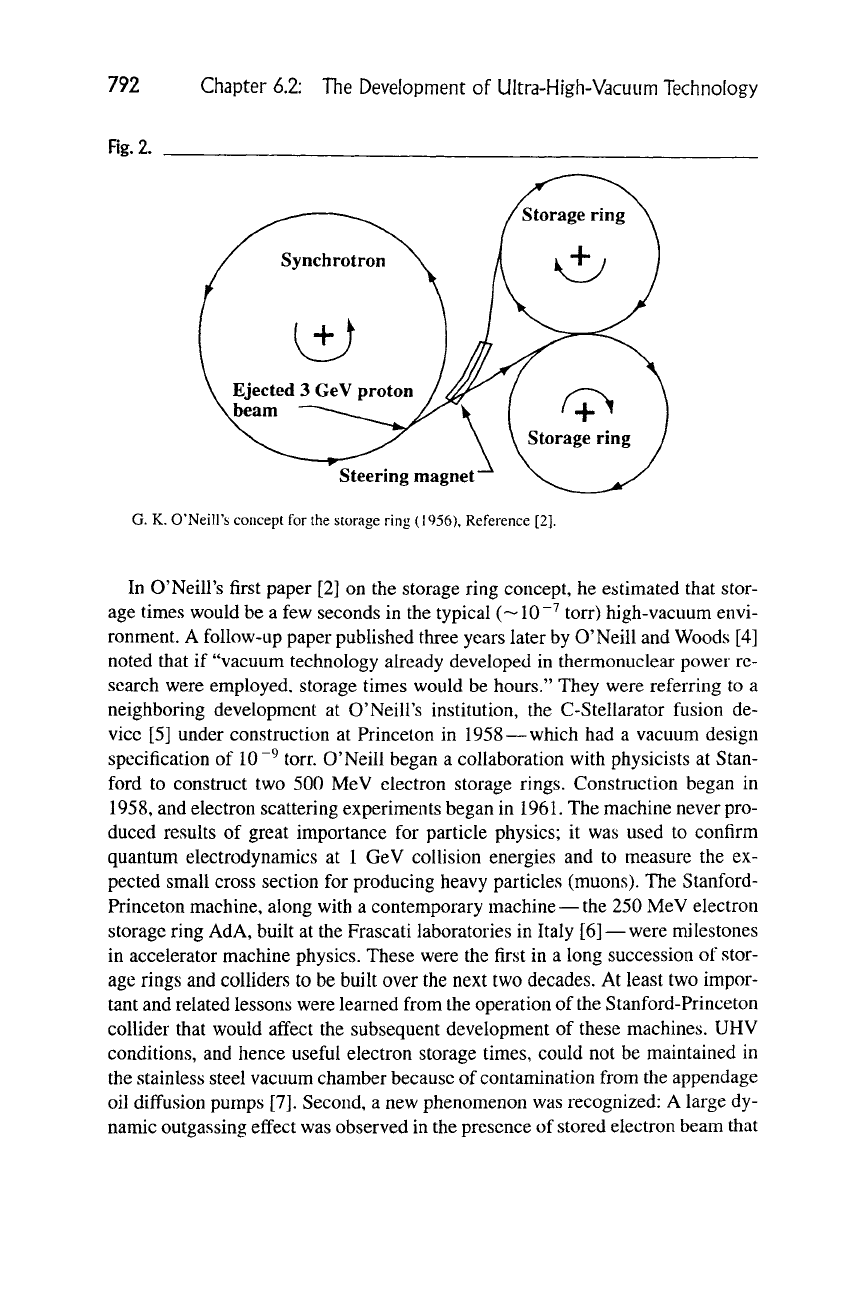
792 Chapter 6.2: The Development of Ultra-High-Vacuum Technology
Fig.
2.
Steering magnet"
G. K. CNeill's concept for the storage ring (1956), Reference [2].
In O'Neill's first paper [2] on the storage ring concept, he estimated that stor-
age times would be a few seconds in the typical (~10~^ torr) high-vacuum envi-
ronment. A follow-up paper published three years later by O'Neill and Woods [4]
noted that if "vacuum technology already developed in thermonuclear power re-
search were employed, storage times would be hours." They were referring to a
neighboring development at O'Neill's institution, the C-Stellarator fusion de-
vice [5] under construction at Princeton in
1958
— which had a vacuum design
specification of
10 ~^
torr. O'Neill began a collaboration with physicists at Stan-
ford to construct two 500 MeV electron storage rings. Constmction began in
1958,
and electron scattering experiments began in
1961.
The machine never pro-
duced results of great importance for particle physics; it was used to confirm
quantum electrodynamics at 1 GeV collision energies and to measure the ex-
pected small cross section for producing heavy particles (muons). The Stanford-
Princeton machine, along with a contemporary machine — the 250 MeV electron
storage ring AdA, built at the Frascati laboratories in Italy
[6]
— were milestones
in accelerator machine physics. These were the first in a long succession of stor-
age rings and colliders to be built over the next two decades. At least two impor-
tant and related lessons were learned from the operation of the Stanford-Princeton
collider that would affect the subsequent development of these machines. UHV
conditions, and hence useful electron storage times, could not be maintained in
the stainless steel vacuum chamber because of contamination from the appendage
oil diffusion pumps [7]. Second, a new phenomenon was recognized: A large dy-
namic outgassing effect was observed in the presence of stored electron beam that
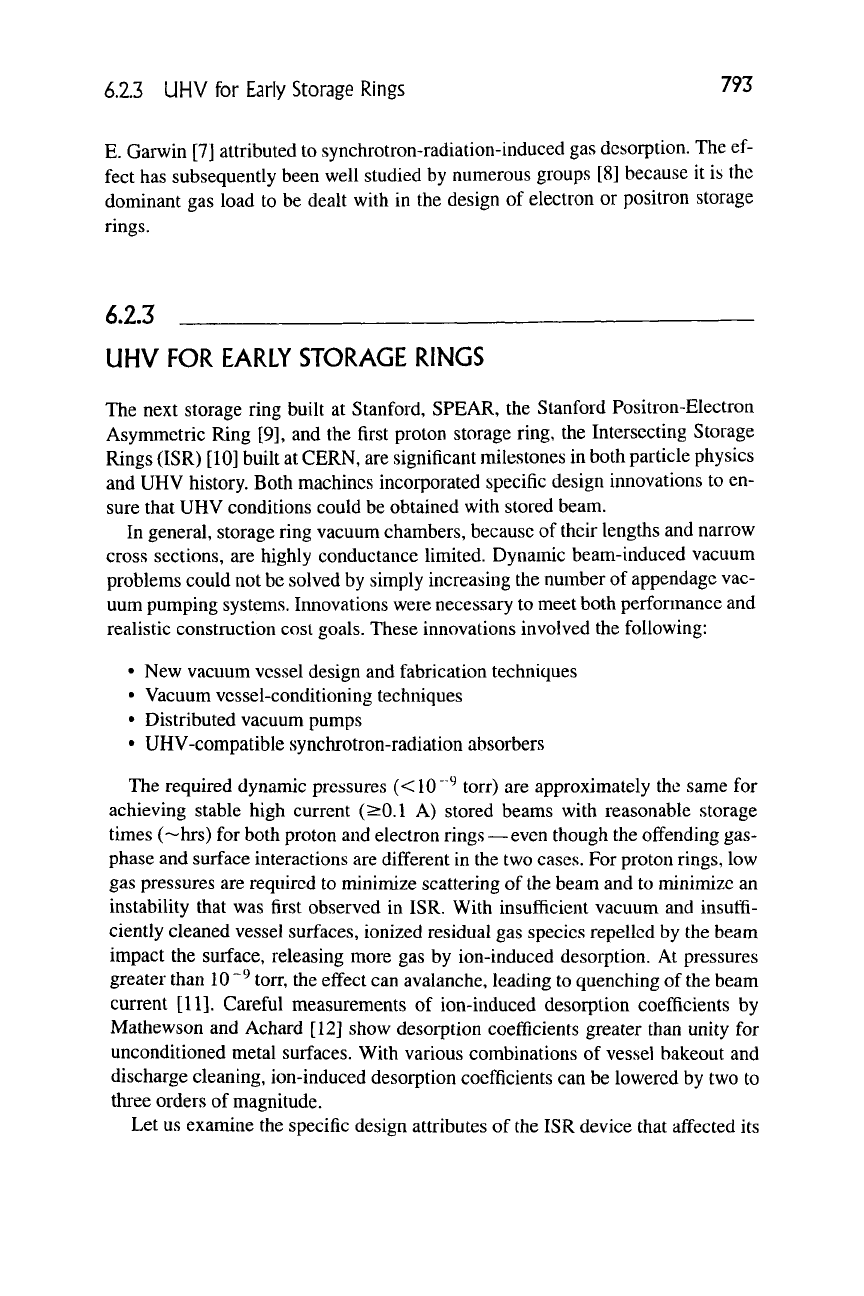
6.23 UHV for Early Storage Rings 793
E. Garwin [7] attributed to synchrotron-radiation-induced gas desorption. The ef-
fect has subsequently been well studied by numerous groups [8] because it is the
dominant gas load to be dealt with in the design of electron or positron storage
rings.
6.2.3
UHV FOR EARLY STORAGE RINGS
The next storage ring built at Stanford, SPEAR, the Stanford Positron-Electron
Asymmetric Ring [9], and the first proton storage ring, the Intersecting Storage
Rings (ISR) [10] built at CERN, are significant milestones in both particle physics
and UHV history. Both machines incorporated specific design innovations to en-
sure that UHV conditions could be obtained with stored beam.
In general, storage ring vacuum chambers, because of their lengths and narrow
cross sections, are highly conductance limited. Dynamic beam-induced vacuum
problems could not be solved by simply increasing the number of appendage vac-
uum pumping systems. Innovations were necessary to meet both performance and
realistic construction cost goals. These innovations involved the following:
• New vacuum vessel design and fabrication techniques
• Vacuum vessel-conditioning techniques
• Distributed vacuum pumps
• UHV-compatible synchrotron-radiation absorbers
The required dynamic pressures (<10"^ torr) are approximately the same for
achieving stable high current (>0.1 A) stored beams with reasonable storage
times (-^hrs) for both proton and electron rings—even though the offending gas-
phase and surface interactions are different in the two cases. For proton rings, low
gas pressures are required to minimize scattering of the beam and to minimize an
instability that was first observed in ISR. With insufficient vacuum and insuffi-
ciently cleaned vessel surfaces, ionized residual gas species repelled by the beam
impact the surface, releasing more gas by ion-induced desorption. At pressures
greater than
10 "'^
torr, the effect can avalanche, leading to quenching of the beam
current [11]. Careful measurements of ion-induced desorption coefficients by
Mathewson and Achard [12] show desorption coefficients greater than unity for
unconditioned metal surfaces. With various combinations of vessel bakeout and
discharge cleaning, ion-induced desorption coefficients can be lowered by two to
three orders of magnitude.
Let us examine the specific design attributes of the ISR device that affected its

794 Chapter 6.2: The Development of Ultra-High-Vacuum Technology
vacuum performance. The ISR consisted of a pair of
1-km-long
vacuum vessels
that intersected at crossing points for colliding beam experiments. Proton beams
with currents up to 20 A at energies up to 28 GeV were stored in each ring. The
long, successful operation of this device from 1971 until 1984 owes much to the
successful design and implementation of the vacuum system by the ISR vacuum
group headed by E. Fischer [13,14]. Some fraction of the effort might be ascribed
to brute force, in terms of incorporating the best of the existing UHV technology
known at the time into the design of the system. For example, the 2-km-long, all
stainless steel vacuum vessel was bakeable in situ to 300°C and was pumped
by 300 triode ion pumps and 70 turbomolecular pumps. A significant effort
was invested in properly characterizing the vacuum environment: 500 modulated
Bayard-Alpert gauges and 36 residual gas analyzers instrumented the system.
The ISR vacuum group developed several vessel-material-conditioning techniques
that were used on many subsequent machines at CERN and elsewhere to optimize
UHV performance. As a result of study of the diffusitivity of hydrogen in stain-
less steel [15], sheet stock that was used for vessel fabrication was prebaked in
vacuum for 2 hours at 900°C, lowering the hydrogenic content by an order of
magnitude. Significant efforts were devoted to developing and qualifying the ef-
fectiveness of chemical recipes for cleaning vacuum materials [16] and to devel-
oping discharge cleaning methods using argon and argon-oxygen mixtures [17].
These surface-conditioning studies were extended to aluminum surfaces [18] in
the 1980s as CERN focused on the design of the 27-km Large Electron Positron
(LEP) Collider, which became operational in 1989 [19].
At about the time the ISR device was being commissioned, the SPEAR device
[20] at Stanford became operational (1972). Many of the design innovations de-
veloped for this collider were incorporated in subsequent electron-positron col-
liders and storage rings. Dynamic pressure requirements of
:^10~^
torr are also
necessary for electron or positron storage rings, but in this case the primary gas-
scattering mechanism is bremsstrahlung losses in electron-molecule collisions
[21].
The beam lifetime determined by this scattering mechanism scales inversely
with molecular mass, thus putting a penalty on the higher-molecular-weight com-
ponents of the residual gas. As mentioned earlier, the source of dynamic gas load
is the synchrotron-radiation-induced desorption. This phenomenon is now well
understood in terms of
gas
desorption by photoelectrons generated by synchrotron
radiation. Measurements to study the phenomenon were first done with electron
sources to simulate the photoelectron emission, including the original measure-
ment (Figure 3) by the SPEAR vacuum design team [7]. Later, actual measure-
ments of photo-induced desorption coefficients were obtained using beam lines
on storage ring light sources by the vacuum groups at CERN [8], Brookhaven
[21],
and KEK in Japan [22].
Measured desorption coefficients start out in the range of
10 ~^
to 10"^ de-
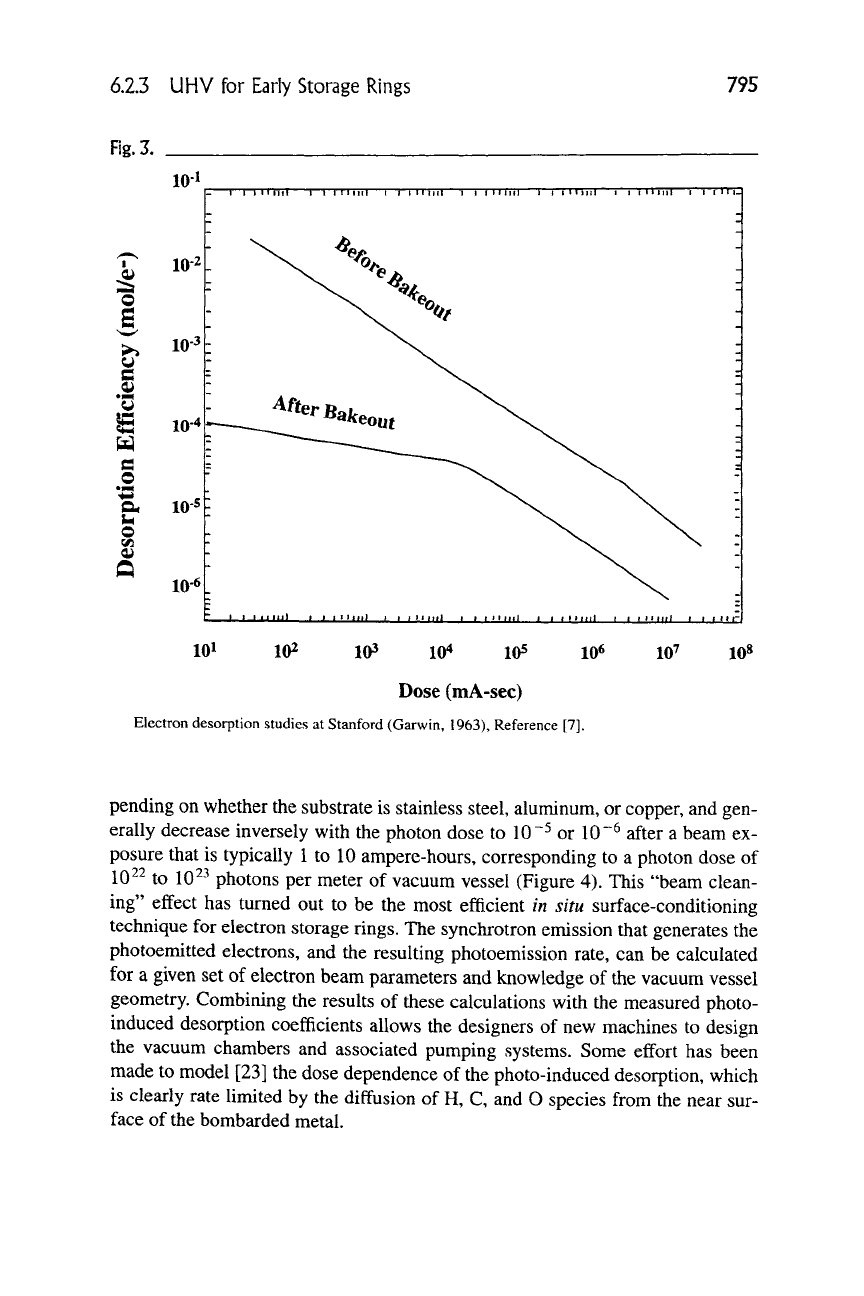
6.2.3 UHV for Early Storage Rings
795
Fig.
3.
W 102 i()3 1Q4 105 106 iQl IQS
Dose (mA-sec)
Electron desorption studies at Stanford (Garwin, 1963), Reference [7].
pending on whether the substrate is stainless steel, aluminum, or copper, and gen-
erally decrease inversely with the photon dose to
10 ~^
or
10 ~^
after a beam ex-
posure that is typically 1 to 10 ampere-hours, corresponding to a photon dose of
10^^
to 10^"^ photons per meter of vacuum vessel (Figure 4). This "beam clean-
ing" effect has turned out to be the most efficient in situ surface-conditioning
technique for electron storage rings. The synchrotron emission that generates the
photoemitted electrons, and the resulting photoemission rate, can be calculated
for a given set of electron beam parameters and knowledge of the vacuum vessel
geometry. Combining the results of these calculations with the measured photo-
induced desorption coefficients allows the designers of new machines to design
the vacuum chambers and associated pumping systems. Some effort has been
made to model [23] the dose dependence of the photo-induced desorption, which
is clearly rate limited by the diffusion of H, C, and O species from the near sur-
face of the bombarded metal.
